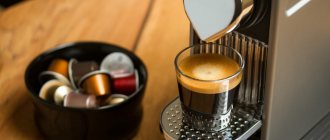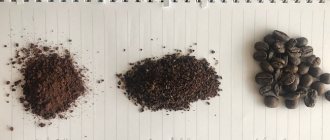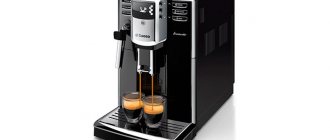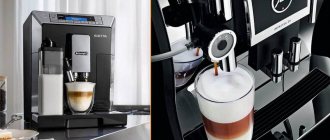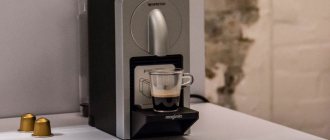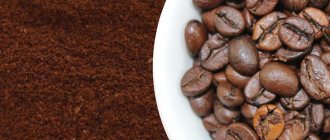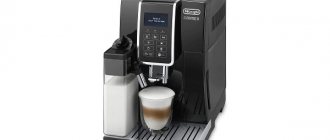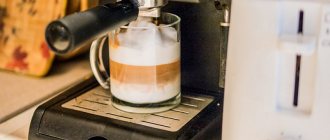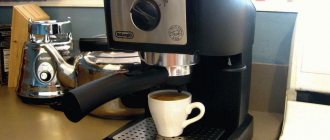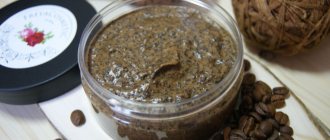What causes a coffee machine to become dirty?
There are two types of device contamination:
- A persistent plaque of calcifications is formed when water rich in calcium ions is heated. Scale accumulates mainly on the water heater, but over time it can fall off and clog other elements of the coffee maker.
- Coffee bean oil – During the process of grinding and brewing coffee, an oily coating is formed that cannot be removed with plain water. Plaque accumulates, which negatively affects the taste (a taste of rancid oil appears).
Even the most careful users who wipe up every drop and clean all filters after every use are faced with contamination problems. The instruction manual notes the need for preventive cleaning, the absence of which will immediately affect the operation of the coffee machine.
How often should you clean?
The frequency of cleaning work depends on several indicators:
- Machine throughput per day - if used for home purposes (3-10 servings of coffee per day), then cleaning is necessary once every 2-3 months. In catering areas, cleaning using special equipment is carried out once a week.
- The hardness of the water used - soft purified water leaves virtually no scale on the elements of the machine, while tap water contains a large amount of calcifications deposited on the walls of the heating element.
- The presence of characteristic signs of clogging of the coffee machine - the cleaning procedure is carried out as quickly as possible in order to reduce the risk of failure of the entire coffee maker system.
Expert opinion
Borodina Galina Valerievna
Some devices are equipped with sensors that remind you of the need for cleaning. If this is not the case, then you need to follow the instructions, where the manufacturer gives recommendations regarding the frequency and frequency of cleansing.
Product range overview
The stores offer a variety of brands. It’s better to use branded ones recommended by the manufacturer, but this is a rather difficult question. Their composition is similar in the type of impact, and in a sense, you may simply be overpaying for the brand. On the other hand, the wrong product can destroy fragile internal parts.
- If you have a branded, high-tech, expensive coffee machine, it is better to take branded anti-scale tablets so as not to spoil anything. As a last resort, you can try universal or Melitta, but definitely no home remedies. If there are no tablets, but there is a liquid branded product, take it.
- For inexpensive coffee machines, universal decalcification tablets may be suitable; you can try options for other brands. It’s good if you bought branded ones before and know the approximate sizes and how many pieces to use.
Here are the approximate prices for anti-scale tablets for coffee machines:
- Jura, Switzerland, 3 pieces – 1600 rubles;
- Bosch Tcz8002, Germany, 3 pcs – 850 rub.;
- Melitta for filter coffee makers, 4 pcs – 350 RUR;
- Melitta for automatic coffee machines, 2 pieces – 450 rubles;
- Bosch/Siemens, 6 pcs – 700 rub.;
- Top House, universal, 8 pieces – 370 RUR;
- Topper for filter coffee machines, universal, 2 pcs – 100 rub.
You can buy anti-scale tablets for your coffee machine at a large hypermarket or order them online. Prices on different sites can vary greatly, so look for promotions and discounts, compare options and choose the best deal for you. On our website you can also familiarize yourself with the range of liquid decalcification products; perhaps you will like this particular option.
How to recognize the need for a procedure?
There are a number of “symptoms” that indicate a clogged machine and the need to clean it:
- Unpleasant bitter taste in coffee.
- Increased time for preparing a standard portion of coffee.
- The finished drink flows out in a very thin stream.
- The outlet temperature of the finished coffee decreases.
- White persistent flakes and sediment appear in the drink.
- Extraneous sounds in the device that were previously absent.
You should not ignore this behavior of the coffee machine, as it can lead to early breakdown and the need for expensive repairs.
Common means and their features
To clean the coffee machine from scale and other contaminants, special cleaning products designed for this purpose, as well as improvised substances that have similar effectiveness, can be used.
Use of special equipment
Coffee machine manufacturers usually indicate cleaning products that can be used for a particular model, along with step-by-step instructions. The most popular of them are the following.
EcoDecalk by DeLonghi
Available in liquid form, a bottle with a dispenser. The main component is citric acid. Suitable for all types of coffee machines.
| Advantages | Flaws |
| Completely natural composition | High cost (about 2000 rubles) |
| Quite a large volume | |
| Does not cause damage to machine elements | |
| Does not harm the environment |
The cleaning product protects heating elements from premature deterioration and gently removes plaque. It washes out well with warm water and does not cause the formation of foam.
Krups
Tablets with active ingredients are suitable for coffee machines of the same brand, but according to experts, they can be used in absolutely any coffee maker.
| Advantages | Flaws |
| Removes not only scale, but also coffee oil | High price (about 1600 rubles for 10 tablets) |
| Can be used for prevention | |
| Dissolves quickly and leaves no odor in the car |
This product is ideal when using hard tap water. In 5-7 minutes, any plaque dissolves and is removed naturally, and the coffee machine works like new.
TOP House
German liquid for cleaning coffee machines combines all the advantages and has no disadvantages. Suitable for all models of coffee makers, carefully removes plaque and has a protective effect against corrosion. A convenient dispenser allows you to measure the required amount of product. The cost is about 300 rubles, which is very economical for any budget.
Available means
You can also descale your coffee machine using conventional means available in the kitchen. If you pay attention to the composition of expensive specialized products, almost all of them contain the main substance – citric acid.
The following products can also be used as cleaners:
Soda Ash
It is dissolved in warm water and poured into the machine, after which coffee without beans is prepared.
Regular soda
It copes well with greasy deposits from coffee and is suitable for manual cleaning of individual removable components.
Coarse salt
Abrasiveness cleans even the most complex contaminants, does not harm the metal and does not provoke the development of corrosion.
Such products can be used for preventive cleaning, and it is recommended to carry out planned activities with a special product.
Composition of anti-scale tablets
There are different cleaning tablets available for coffee machines, and it is important to make sure that what you buy is specifically for removing calcium deposits, because there are also general cleaning products available, as well as for removing coffee oils.
Anti-scale tablets for coffee machines are usually labeled as CALC, Descaling, Decalcifier, or in Russian - for decalcification or descaling.
Compound:
- Maleic acid – for water softening;
- Sulfamic acid – for dissolving calcium deposits and disinfection (does not spoil metal);
- Sodium bicarbonate - to remove contaminants, soften water and remove foreign odors;
- Benzotriazole - to protect internal parts from corrosion and destruction.
The composition contains quite caustic substances that remove plaque crust. Wash your hands thoroughly after handling the tablet. Don't rub your eyes or face. If accidental contact with skin or mucous membranes occurs, rinse them with plenty of water and consult a doctor if an allergic reaction occurs, taking with you the packaging on which the composition is written.
Some anti-scale tablets are NSF certified, which means they are safe for your health. However, do not allow them to come into contact with your eyes or mouth.
Mechanical cleaning: sequence of actions
Before cleaning the machine, you need to remove the used coffee and the coffee grinder compartment where the beans are located. Clean the holder where ground coffee and capsules are placed in the capsule model. Additional containers containing cream, milk, and chocolate are also removed.
When the machine is ready, start working:
- Heat the water to 35-40℃, dissolve the cleaning agent in it, according to the instructions. If you use citric acid or soda with salt, keep the proportion of 1 tablespoon per 10 liters of water.
- Place the water container in place and connect the tubes. You need to place a deep container in the drainage area where it will come out.
- Drain about 100-150 ml through the hot water button, then turn off the device for 20-30 minutes.
- Turn on the machine and select several different coffee preparation modes (3-4 will be enough). The drained water should be drained.
- Turn off the machine, disconnect the water container. Rinse it under running water. Pour in regular water that is used to make coffee. Prepare 2-3 cups of coffee without coffee. This will remove any remaining cleaning product.
- Prepare 2-3 cups of real coffee, but do not use them for food.
If the coffee after cleaning acquires an unpleasant taste or unusual smell, the cleaning procedure should be repeated, increasing the volume of water for the final stage.
Some coffee machine models have an auto-clean function. To do this, you need to pour detergent into the indicated container and press the corresponding button. All the nuances of such work are described in the instructions. But not every model can boast a set of such additional functions. This does not mean that the car does not need cleaning.
Before carrying out this kind of manipulation, it is important to read the instructions. There are nuances specific to a particular model; failure to comply with them can result in breakdowns.
Automatic decalcification
This function is not available in all coffee machines; for example, drip and geyser coffee makers will have to be descaled manually. Most modern models have an auto-decalcification function, which means there is hardly any need to disassemble the structure and wash the parts.
The coffee machine itself will signal that it needs to be cleaned. This may be a flashing indicator light, an audible signal, or information on the display on the front control panel.
All you need to do is take the necessary descaling agent for your coffee machine, pour it into a container of water and start the self-cleaning option. Next, you only have to drain the dirty water and periodically add it to the boiler.
Some of the newest models - Bosch, Delonghi, Krups coffee machines - have a fine filter in their design. It is installed directly in the water boiler and is an excellent barrier to the penetration of dirt, clogging, various deposits and plaque. Your task in this case is to regularly replace the filter.
Absolutely forbidden
What cleaning products do you use?
Special Handy
In order not to provoke premature breakdown of the coffee machine, it is strictly prohibited:
- Use pure or diluted vinegar as a cleaner - acetic acid helps break down the surface protective layer of parts, which accelerates the process of metal corrosion.
- Use dishwashing, glass, and plumbing detergents - these substances, even after thoroughly washing the device, can settle on the walls and get into the coffee, causing a negative effect on the human body.
- Instead of water, pass Coca-Cola or other drinks like Soda through the machine - the release of carbon dioxide can lead to breakage of small parts, which will render the entire structure unusable.
- Pour dry powders into the machine, then add water - all products are pre-dissolved in warm water, after which they are poured into a special container, from where the liquid is taken into the coffee machine.
Expert opinion
Borodina Galina Valerievna
It is recommended to thoroughly rinse all parts of the device that came into contact with the cleaner. This ensures continued safety in preparing and drinking coffee.
Where do you place the cleansing tablets?
Most often, tablets for cleaning a coffee machine are placed in the ground coffee hopper, since it provides access to the filter strainer. In coffee machines that do not have such a hopper, the tablet is placed directly on the strainer. Devices with a removable brew unit allow you to remove the filter and clean all its holes clogged with deposits of coffee oils using a miniature brush and soap solution. It is absolutely unacceptable to put the cleaning tablet into the water tank. After starting the program, the device will carry out a washing cycle. The water coming out of the drink outlets should be foamy and whitish in color. This is evidence that the tablet performs its functions well in eliminating coffee deposits.
How to choose the right product?
To be as confident as possible in the correctness and effectiveness of cleaning the coffee machine, you must follow 3 rules when choosing a product:
- Always use products recommended by the manufacturer, since for some models the use of uncertified products does not guarantee uninterrupted operation of the device.
- Do not use vinegar and essence, as this can lead to complete or partial destruction of metal parts, which will lead to complete unusability of the part.
- Be sure to read the instructions for the product and follow all recommendations.
As for the form of the cleaning product, there are no special differences between them. Tablets are more convenient to store, but they take longer to dissolve. The gel dissolves well and quickly in water, but it is in a bottle for 3-4 applications. The liquid dissolves easily in water, but contains a lower concentration of cleaning agent.
Automatic coffee machine
To clean an automatic coffee machine, you need tablets or powder to clean the internal mechanisms of coffee oils and a decalcifier to get rid of scale.
The cleaning algorithm is different for each individual coffee machine, so we cannot give any clear recommendations, except that you need to study the instructions. If it is not there or has disappeared, you can always find instructions on the Internet, indicating the full name of the coffee machine model.
As for cleaning the coffee machine with vinegar or citric acid, it’s better not to. Vinegar just won't do the trick, and citric acid sometimes eats away rubber gaskets and seals aluminum tubes. Repairing a coffee machine can be more expensive than buying a special cleaning product.
The frequency of cleaning directly depends on the frequency of coffee consumption. The coffee machine needs to be cleaned of oils every 100 cups. Many coffee machines count cups automatically and notify you when it's time to clean them, so you don't have to count cups yourself. It is enough to descale your coffee machine once every six months.
You cannot skip cleaning your automatic coffee machine. And it’s not just about the taste of the coffee, which will deteriorate over time. The reason is also that if the coffee machine is not cleaned, it will break down, and repairs will cost much more.
What happens if cleaning is not carried out?
Some coffee machine owners accidentally or intentionally forget about preventive cleaning. This is fraught with the development of such unpleasant consequences:
- Unpleasant musty smell of coffee mixed with greasy stains.
- Cloudy dense sediment at the bottom of the cup.
- Adding loud sounds that were not there before.
- The coffee machine fails without the possibility of repair.
Prevention is the key to good and long-term operation of any equipment. If you ignore the manufacturer's advice, you will have to spend a lot of money on repairs.
Useful tips
To maximize the service life of the device, you must:
- Use only filtered bottled water, which contains minimal calcium impurities that provoke plaque formation. So cleaning can be done once every 2-3 months.
- Change filters in a timely manner so that they do not become clogged and cause clogging of small pipes.
- Clean using specialized products as required by the manufacturer.
Expert opinion
Borodina Galina Valerievna
It is recommended to clean the milk cappuccino maker several times a day. This allows you to remove remaining milk fat and prevent souring of the product that gets into the coffee.
